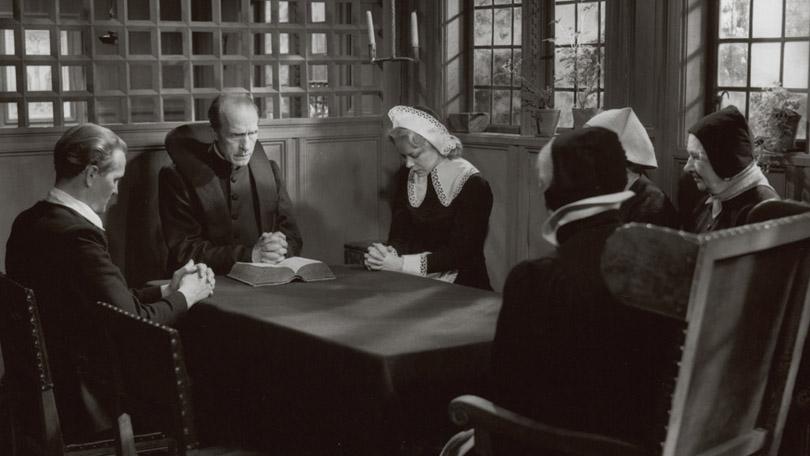Day of Wrath premiered on 13 November 1943 at the World Cinema in Copenhagen.
The reviewers were generally disappointed. They criticised the film for its lack of pace, as is apparent from their headlines: "'Day of Wrath' lacked pace and nerve” (Politiken), "The pace killed 'Day of Wrath'" (Berlingske Tidende) and "Movement in place" (Aftenbladet). Several reviewers criticised Dreyer’s casting – e.g., despite her fine acting, Thorkild Roose is said to be too old for the role, older even than her mother! – while most questioned the film’s style, notably its acting style, calling it heavy, high strung, pathetic and elaborately artificial.
On the other hand, they generally praised Dreyer’s images, "pictorial effects of such saturated beauty that no one else in Denmark, perhaps very few places elsewhere in the world, could draw out anything like it with a film camera" (Nationaltidende). "Its visual treatment is excellent through and through, although the basic tone of the film is dark and gloomy" (Berlingske Tidende). "As a filmic painter Dreyer is altogether supreme. He paints with brilliant lighting effects, and his scenic and nature shots are marvels of beauty" (Politiken). Most reviewers also singled out Anna Svierkier for her performance as Herlufs Marte.
While critics had harsh words for Day of Wrath, many ordinary people voiced their enthusiasm for Dreyer’s film and reported being deeply touched. B.T. asked two cinemagoers – a wallpaperer and a candidate of theology – for their opinions on the film after the show, and their impressions were altogether more favourable. (B.T., 16/11-43)
There were letters to the editors. One, from Charlotte Andersen, a retired school principal, reads, "I have never left a movie theatre with a more definite conviction of having been face to face with great art!" (Berlingske Tidende, 17 Nov. 1943). Under the headline, "A Layman Looks at 'Day of Wrath,'" one Knud Strandgaard opens his letter to the editors as follows, "If the observations of a plain layman stood any chance of getting through, your reputation as a film director would have been under serious threat. Having read the newspapers’ criticisms, I was already familiar with the guidelines for analysis and was ready to assault your work. In essence, all it took was adopting healthy and plain human opinions before an unnatural and overexposed product, moreover one that treats a subject that is far from our own time and its problems. All that was missing was watching the film, but this I simply considered to be an altogether unnecessary formality. Now I have seen the film, and I have abandoned all murderous plans” (Børsen, 16 Dec. 1943). Many people personally wrote or called Dreyer to express their joy over the film.
After the film’s first week at World Cinema, Aftenbladet on 20 Nov. 1943 carried a paragraph making it plain that Day of Wrath was slowly becoming an audience hit: "For every passing day admissions are finer. The theatre daily receives stacks of letters from people voicing their opinion about the film in the most enthusiastic of terms."
On 25 November, World Cinema and the film’s producer, Tage Nielsen, invited members of the Studenterforeningen (students’ association) to a free matinee screening of the film. The purpose was to extend the discussion about Danish film and cinema that was going on in the daily papers, and in Studenterforeningen, in connection with the reception of Day of Wrath. Sixteen hundred students showed up and, as intended, a lively debate ensued, to which the papers devoted an unusual amount of column space. Apart from opinions about Day of Wrath in particular and cinema in general, an excited debate arose about the qualifications of film critics. Dreyer himself showed up for Studenterforeningen’s evening debates and presented his thoughts on the film and, not least, his stylistic decisions.
On 26 December, Day of Wrath opened in a number of provincial cinemas to a generally more favourable critical reception. Over the next eight to nine months, the film toured every corner of the country and received lots of publicity. There are no available records of the film’s admissions, but several newspaper paragraphs report that, by early January 1944, more than 110,000 people had seen the film in Greater Copenhagen alone.
On 23 November 1946, as the first Danish sound film ever, Day of Wrath opened theatrically in London, where it was enthusiastically received by critics, several judging it to be among the year’s best films. In Norway, Sweden, France, Italy and the United States the film was likewise theatrically – and successfully – shown.
By Lisbeth Richter Larsen | 03. June
